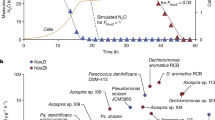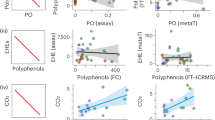Abstract
THE mechanisms and pathways involved in the degradation of pesticides have received more attention as efforts to define the extent of environmental contamination by these chemicals have increased. Complex interrelationships have been found between the soil microflora and organophosphate insecticides, such as ‘Diazinon’1–3. In the case of ‘Diazinon’, utilization of the chemical by an Arthrobacter sp. and a Streptomyces sp. has been shown to alter the existing microbial population balance by stimulating a selective enrichment of these species3. Labelled carbon dioxide was evolved when ‘Diazinon’ labelled on the C1 of the ethyl ester was incubated with a species of Arthrobacter for 24 h. Similarly, labelled carbon dioxide was given off when the same labelled insecticide was injected into soil which contained an unidentified microbial population. We had been concerned with the pyrimidinyl ring of the ‘Diazinon’ molecule, and the possible differentiation of the degradative pathways associated with microbial metabolism by which the Arthrobacter and the Streptomyces that emerged as the predominant successive microfloral forms in soil treated with ‘Diazinon’ could attack the ring moiety of this compound.
This is a preview of subscription content, access via your institution
Access options
Subscribe to this journal
Receive 51 print issues and online access
$199.00 per year
only $3.90 per issue
Buy this article
- Purchase on Springer Link
- Instant access to full article PDF
Prices may be subject to local taxes which are calculated during checkout
Similar content being viewed by others
References
Ahmed, M. K., and Casida, J. E., J. Econ. Entomol., 51, 59 (1958).
Getzin, L. W., and Rosefield, I., J. Econ. Entomol., 59, 512 (1966).
Gunner, H. B., Zuckerman, B. M., Walker, R. W., Miller, C. W., Deubert, K. H., and Longley, R. E., Plant and Soil, 25, 249 (1966).
Bates, J. L., and Liu, P. V., J. Bact., 86, 585 (1963).
Gale, E. F., Biochem. J., 34, 853 (1940).
Nurmikko, V., Experientia, 12, 245 (1956).
Alexander, M., Introduction to Soil Microbiology (John Wiley and Sons, New York and London, 1961).
Author information
Authors and Affiliations
Rights and permissions
About this article
Cite this article
GUNNER, H., ZUCKERMAN, B. Degradation of ‘Diazinon’ by Synergistic Microbial Action. Nature 217, 1183–1184 (1968). https://doi.org/10.1038/2171183a0
Received:
Revised:
Issue Date:
DOI: https://doi.org/10.1038/2171183a0
This article is cited by
-
Optimization of diazinon biodegradation from aqueous solutions by Saccharomyces cerevisiae using response surface methodology
AMB Express (2017)
-
Methanogenesis mediated by methylotrophic mixed culture
Applied Biochemistry and Biotechnology (1994)
-
Influence of pesticides and some of the oxidized analogues on microbial populations, nitrification and respiration activities in soil
Bulletin of Environmental Contamination and Toxicology (1980)
Comments
By submitting a comment you agree to abide by our Terms and Community Guidelines. If you find something abusive or that does not comply with our terms or guidelines please flag it as inappropriate.



